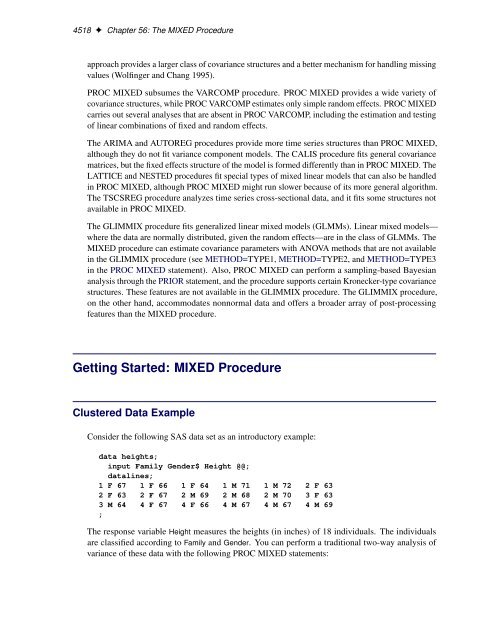SAS/STAT 922 User's Guide: The MIXED Procedure (Book Excerpt)
SAS/STAT 922 User's Guide: The MIXED Procedure (Book Excerpt)
SAS/STAT 922 User's Guide: The MIXED Procedure (Book Excerpt)
You also want an ePaper? Increase the reach of your titles
YUMPU automatically turns print PDFs into web optimized ePapers that Google loves.
4518 ✦ Chapter 56: <strong>The</strong> <strong>MIXED</strong> <strong>Procedure</strong><br />
approach provides a larger class of covariance structures and a better mechanism for handling missing<br />
values (Wolfinger and Chang 1995).<br />
PROC <strong>MIXED</strong> subsumes the VARCOMP procedure. PROC <strong>MIXED</strong> provides a wide variety of<br />
covariance structures, while PROC VARCOMP estimates only simple random effects. PROC <strong>MIXED</strong><br />
carries out several analyses that are absent in PROC VARCOMP, including the estimation and testing<br />
of linear combinations of fixed and random effects.<br />
<strong>The</strong> ARIMA and AUTOREG procedures provide more time series structures than PROC <strong>MIXED</strong>,<br />
although they do not fit variance component models. <strong>The</strong> CALIS procedure fits general covariance<br />
matrices, but the fixed effects structure of the model is formed differently than in PROC <strong>MIXED</strong>. <strong>The</strong><br />
LATTICE and NESTED procedures fit special types of mixed linear models that can also be handled<br />
in PROC <strong>MIXED</strong>, although PROC <strong>MIXED</strong> might run slower because of its more general algorithm.<br />
<strong>The</strong> TSCSREG procedure analyzes time series cross-sectional data, and it fits some structures not<br />
available in PROC <strong>MIXED</strong>.<br />
<strong>The</strong> GLIMMIX procedure fits generalized linear mixed models (GLMMs). Linear mixed models—<br />
where the data are normally distributed, given the random effects—are in the class of GLMMs. <strong>The</strong><br />
<strong>MIXED</strong> procedure can estimate covariance parameters with ANOVA methods that are not available<br />
in the GLIMMIX procedure (see METHOD=TYPE1, METHOD=TYPE2, and METHOD=TYPE3<br />
in the PROC <strong>MIXED</strong> statement). Also, PROC <strong>MIXED</strong> can perform a sampling-based Bayesian<br />
analysis through the PRIOR statement, and the procedure supports certain Kronecker-type covariance<br />
structures. <strong>The</strong>se features are not available in the GLIMMIX procedure. <strong>The</strong> GLIMMIX procedure,<br />
on the other hand, accommodates nonnormal data and offers a broader array of post-processing<br />
features than the <strong>MIXED</strong> procedure.<br />
Getting Started: <strong>MIXED</strong> <strong>Procedure</strong><br />
Clustered Data Example<br />
Consider the following <strong>SAS</strong> data set as an introductory example:<br />
data heights;<br />
input Family Gender$ Height @@;<br />
datalines;<br />
1 F 67 1 F 66 1 F 64 1 M 71 1 M 72 2 F 63<br />
2 F 63 2 F 67 2 M 69 2 M 68 2 M 70 3 F 63<br />
3 M 64 4 F 67 4 F 66 4 M 67 4 M 67 4 M 69<br />
;<br />
<strong>The</strong> response variable Height measures the heights (in inches) of 18 individuals. <strong>The</strong> individuals<br />
are classified according to Family and Gender. You can perform a traditional two-way analysis of<br />
variance of these data with the following PROC <strong>MIXED</strong> statements:

















